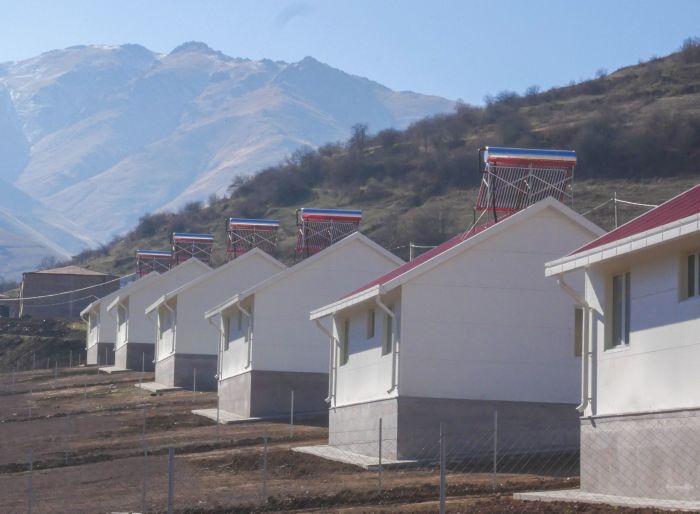
SVARANTS, Armenia — Several families displaced by ethnic cleansing in their ancient Christian homeland more than two years ago were given new homes and plots of land on Tuesday through a charitable initiative seeking to help revitalize a rural Armenian mountain village.
The Tufenkian Foundation and its partner organizations have cut the ribbon on a pilot refugee village in Svarants, completing the first 10 of 20 new homes in the upper reaches of Armenia's mountainous Tatev Municipality, in the southern Syunik province, which borders Iran and Azerbaijan.
The new homes, which come with adjoining plots of land and a barn, were built specifically to help families rebuild their lives around the agricultural and livestock work they were doing before Azerbaijan's 2023 invasion of Nagorno-Karabakh, a predominantly Armenian region known affectionately to Armenians as the Republic of Artsakh.
After a months-long military blockade, more than 120,000 ethnic Artsakh Armenians were forced from their homes in September 2023, and most have lived for two years throughout Armenia with what Artsakh leaders say has been inadequate social integration.
Although the Armenian government offers housing assistance programs, leaders of the Artsakh government-in-exile contend that those programs don't prioritize keeping Artsakh communities together to preserve their shared heritage.
But the Tufenkian Foundation's "Come to Svarants" initiative, in collaboration with various NGOs, government and international development agencies, aims to do just that. Families moving into these 10 homes all come from the Martakert region of Artsakh.
Tuesday's ribbon-cutting ceremony was attended by village residents, local and provincial government leaders, along with partners from various international development agencies and nonprofits.
“This neighborhood is a key component of our Syunik Village Revitalization Program and is one of the very few collective resettlement initiatives serving families displaced from Artsakh," Antranig Kasbarian, a trustee of the Tufenkian Foundation and its director of development, said. "Our work extends far beyond building homes — we are also investing in the long-term socio-economic and infrastructure development that will benefit the entire village.”
In partnership with international development agencies, government agencies and nonprofits, the Syunik Revitalization Program aims to strengthen Armenia’s southern province that has faced much economic hardship through sustainable resettlement, socio-economic development and infrastructural improvements.

'A revival point'
The political leaders in the village of about 250 people hope that the new project, which will also include infrastructure improvements benefiting all residents, will spark a "revival" of sorts for the town.
Svarants, like other municipalities in Syunik, is facing population declines as people search for employment and move toward Yerevan, the capital city and home to about a third of Armenia's 3 million population.
"The work that the Tufenkian Foundation has been implementing here is huge. We have huge plans for the future as well," declared Svarants Mayor Samvel Lalayan through a translator during a September meeting with community members and international delegates visiting Armenia with the United States-based nonprofit Save Armenia.
"It is going to be a revival point for this village. Tufenkian Foundation also intends to build a kindergarten that is going to be located in front of the ministry building in the village, [as well as a] playground for kids. I'm pretty sure that if we help each other, we are going to be in a position to thrive in this village."
The Tufenkian Foundation, launched in 1999 by entrepreneur James Tufenkian to address the social, economic, cultural and environmental challenges facing Armenia, believes that Syunik, in the southern region of Armenia, offers Artsakh Armenians "familiar surroundings" and a "shared cultural heritage."
The new initiative will enable displaced individuals to engage in the same types of breeding and agricultural work they were doing in Martakert before they fled their homes.
"I used to have my own farm," one Artaskh man said through a translator during the meeting in an old school building attended by The Christian Post. "I am engaged in exactly the same activity here."
The new neighborhood will feature 750-square-foot homes with ample space for a family of four to five members. Next to each house will be 10,000-square-foot fenced plots of land. Each home will also have access to a barn to store cattle.
Families will also receive agricultural support tailored to their experience and preferences. The goal is to help them become self-sufficient in a short period.
Work on the project began in July and was facilitated by an architect from Artsakh and two Artsakh-based construction firms.
After concrete was laid, construction of the homes started on Aug. 8, coincidentally the same day that the Armenian and Azerbaijani leaders signed a peace deal and memorandum of understanding at the White House. The homes seek to provide long-term comfort and stability for these families.
As the majority of the population in Svarants is engaged in cattle breeding, the community has hundreds of hectares of pastures that can hold thousands of sheep, Lalayan and local Tufenkian Foundation leader Edvin Grigoryan told delegates in September. The remaining land can be used to grow hay or other crops.
Other startup support will include selected livestock and high-quality seeds and saplings to support farming and food production, they said. The foundation will assist with home furnishings and offer small grant opportunities to support the development of business initiatives.
The Tufenkian Foundation had previously provided a tractor to help villagers collect grass for hay. The foundation procured a machine for about $25,000 and donated it to the village.
An effort is underway to build a new drinking water pipeline for the community. The old pipeline is outdated and needs to be dismantled before a new one can be laid.
The village is currently without gas for heating, they said, but efforts are underway to secure heating through solar panels, with the support of a United Nations agency. This initiative would benefit the entire village, not just the new homes.
Another concern for the Svarants has been the potential relocation of its public school to a nearby village closer to Tatev, Mayor Lalayan said.
"Authorities want to relocate the school in this village to another place that will be closer to the Tatev community," Lalayan, who has been in office since 2021, said. "We want to keep a standalone school for this village. Here is where the Tufenkian Foundation is standing next to us to help us keep the school here."
"You may see that the area of the school is quite large. Once I have reached an agreement with the government, once we finish the construction of the village, they are going to help us with laying the asphalt. There is going to be an asphalt road that will lead to the center of the village. I am pretty sure that once the asphalt reaches the center of the village, gravel roads won't be a problem."
Employment concerns
Artsakh Armenians moving into the new homes were cautious when discussing their future outlook during the meeting with Save Armenia delegates in September.
Some voiced concern about the limited employment opportunities in the area, aside from agriculture and cattle breeding, for those who are physically unable to perform either. Residents discussed ideas for other job-creating economic outputs that could be generated in the region to support Svarants and other similarly situated villages.
Some were also concerned about the resources required to establish a cattle breeding business in unfamiliar surroundings. Others expressed concern about the village's aging population and its impact on the labor force.
"Employment is an issue that needs to be fixed," one man said in a meeting, according to the translator.
An Artsakh Armenian father of five who spoke with The Christian Post after the meeting said they have felt "very welcomed" and want the best future for their families.
"I said, 'What are the plans? Are we going to stay here? Are we going to leave this place?'" the man told CP. "We are not going anywhere. We are going to stay here."
"[I have a] very, very deep faith. I have five children; they are all underage," he added. "The only thing we are not comfortable with is the employment, no jobs. People are hard-working; it doesn't really matter what type of work."
Kasbarian stated there would be more "intensive conversations" about the next steps for how they will work together to address existing concerns after the village's opening.
Mayor Lalayan expressed hope that the revitalization of Svarants could give the village a competitive edge over surrounding towns and attract more people, as well as potential job opportunities.
"I am pretty sure that the previous generation who used to live here and relocated to other places, at some point, they are going to come back," the mayor said, according to the translator. "I am pretty sure that the locals and the displaced people are going to become very good friends. That will guarantee the revival of this village."
News Source : https://www.christianpost.com/news/christian-ethnic-cleansing-survivors-could-spark-towns-revival.html
 Your post is being uploaded. Please don't close or refresh the page.
Your post is being uploaded. Please don't close or refresh the page.





